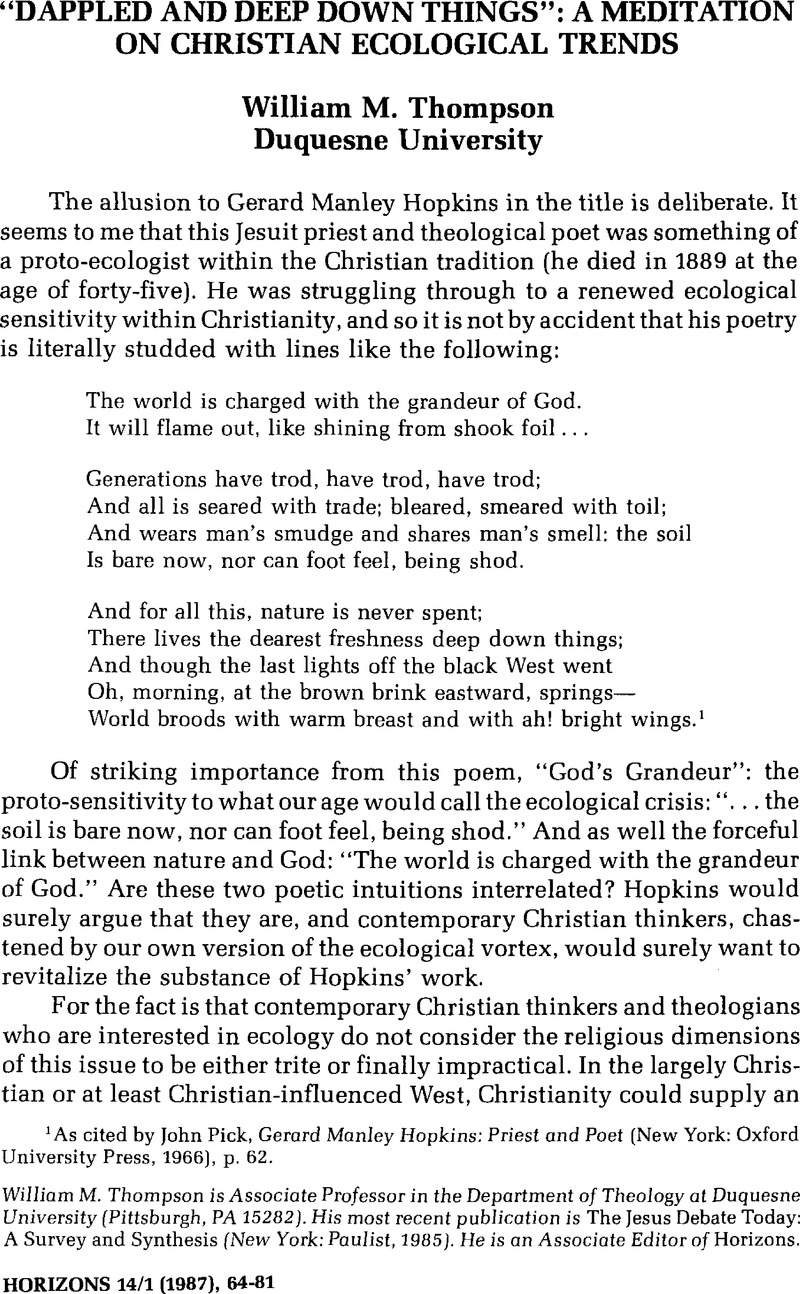No CrossRef data available.
Article contents
“Dappled and Deep Down Things”: A Meditation on Christian Ecological Trends
Published online by Cambridge University Press: 09 September 2014
Abstract

- Type
- Editorial Essays
- Information
- Copyright
- Copyright © The College Theology Society 1987
References
1 As cited by Pick, John, Gerard Manley Hopkins: Priest and Poet (New York: Oxford University Press, 1966), p. 62.Google Scholar
2 Carmody, John, Ecology and Religion: Toward a New Christian Theology of Nature (New York: Paulist, 1983), p. 31.Google Scholar
3 We need to exercise a certain amount of caution when we Christian theologians speak of the tendency to exalt man over nature in our tradition. It is decidedly man and not all humans (viz., women) that we have in mind, if we listen to what feminist theologians are saying.
4 Davis, Charles, in his Body as Spirit: The Nature of Religious Feeling (New York: Seabury, 1976), esp. pp. 35–38Google Scholar, although speaking of the human body, first suggested to me the three trends which I try to develop and to extend to the ecological issue in this essay.
5 1,6,3 (Roberts, Alexander and Donaldson, James, eds., The Ante-Nicene Fathers, 1 [Grand Rapids, MI: Eerdmans, 1885], p. 324Google Scholar). So far we lack texts by the gnostics themselves illustrating this, but see Rudolph, Kurt, Gnosis: The Nature and History of Gnosticism (San Francisco: Harper and Row, 1983), p. 254.Google Scholar
Studies that I have found especially suggestive of this hedonistic trend are: Davis particularly, ibid.; Cobb, John B. Jr., , “Sociological Theology or Ecological Theology” in his Process Theology as Political Theology (Philadelphia: Westminster, 1982), pp. 111–34;Google ScholarSoelle, Dorothee with Cloyes, Shirley A., To Work and To Love: A Theology of Creation (Philadelphia: Fortress, 1984);Google ScholarTracy, David and Lash, Nicholas, eds., Cosmology and Theology, Concilium 166 (New York: Seabury, 1983);Google Scholar and Woods, Richard, Symbion: Spirituality for a Possible Future (Santa Fe, NM: Bear & Co., 1982).Google ScholarRuether, Rosemary Radford, “Women, Body, and Nature: Sexism and the Theology of Creation” in her Sexism and God-Talk: Toward a Feminist Theology (Boston: Beacon, 1983), pp. 72–92Google Scholar, is indispensable for sensitizing one to the “feminist edge” of all of our three trends.
Somewhat in a class apart is the work of the Islamic traditionalist Nasr, Seyyed Hossein, Man and Nature: The Spiritual Crisis of Modern Man (London: Mandala, 1976)Google Scholar, and the Native American study of Vine Deloria, Jr., God is Red (New York: Grosset & Dunlap, 1973).Google Scholar Both of these highly intensive critiques of late, Western-Christian narcissism can be fruitfully if painfully consulted by today's Christian theologian.
6 Rudolph, p. 253.
7 The reader will find suggestive insights on the “urban shift” in Ruether, Rosemary Radford, New Woman/New Earth: Sexist Ideologies and Human Liberation (New York: Seabury, 1975), pp. 6–13Google Scholar, and more fully in Fagan, Brian M., People of the Earth: An Introduction to World Prehistory (Boston: Little, Brown, 1983), pp. 264–434Google Scholar, esp. 264-80. For the gnostics, see Perkins, Pheme, The Gnostic Dialogue: The Early Church and the Crisis of Gnosticism (New York: Paulist, 1980), pp. 1–22.Google Scholar
8 Hexaemeron 6, 47, and De Isaac 54, as cited and interpreted by Miles, Margaret R., Augustine on the Body (Missoula, MT: Scholars Press, 1979), pp. 58–59.Google Scholar
Studies that I have found especially suggestive of this dualistic trend are: Davis particularly; and Santmire, H. Paul, The Travail of Nature: The Ambiguous Ecological Promise of Christian Theology (Philadelphia: Fortress, 1985).Google Scholar This work interprets the Christian tradition as a struggle between this dualistic trend and the sacramental trend (to be treated in the next section). Older, but still helpful, is Bonifazi, Conrad, A Theology of Things: A Study of Man in His Physical Environment (Philadelphia: Lippincott, 1967).Google Scholar
9 As cited in Meister Eckhart: A Modern Translation, trans. Blakney, Raymond B. (New York: Harper Torchbooks, 1941), pp. 82–91 at 90.Google Scholar
10 Ruether, p. 81.
11 Plato is rather complex on this issue. Apparently he moved beyond an anti-body stance in his Philebus especially, where he gives a quite positive view of the body and matter. See Grube, G. M. A., Plato's Thought (Boston: Beacon, 1968), pp. 51–86.Google Scholar
12 14, 3 (Augustine: City of God, ed. Knowles, David [Baltimore: Penguin, 1972], p. 551Google Scholar).
13 Davis, p. 39.
14 Ibid.
15 Studies that I have found especially suggestive of this sacramental trend are: Davis and Carmody particularly; Jentzen, Grace, God's World, God's Body (Philadelphia: Westminster, 1984);Google Scholar Santmire; and Woods. Hendry, George S., Theology of Nature (Philadelphia: Westminster, 1980)Google Scholar, “evangelically” tries to rehabilitate the biblical creation theology through an ecological key. Soelle and Cloyes, and Tracy and Lash study creation theology too, Tracy also building somewhat upon the Jesus event.
16 Ruether, p. 87.
17 Ibid.
18 Carmody, p. 130.
19 Solzhenitsyn, Alexander, “Repentance and Self-Limitation in the Life of Nations” in Solzhenitsyn, A.et al., eds., From Under the Rubble (New York: Bantam, 1976), pp. 104-42 at 133, 134, and 139.Google Scholar
20 Ruether, p. 88.
21 Woods, Richard, Mysterion: An Approach to Mystical Spirituality (Chicago: Thomas More, 1981), pp. 75–107Google Scholar, is especially good on this. Also helpful for increasing one's ecological sensitivity is Hart, John, The Spirit of the Earth (New York: Paulist, 1984).Google Scholar
22 Cobb, p. 120; see pp. 120-21, 126-33. The Christian might fruitfully consult Davies, W. D., The Gospel and the Land: Early Christianity and Jewish Territorial Doctrine (Berkeley: University of California Press, 1974), esp. pp. 366–76Google Scholar, for the similarities and differences between Judaism and Christianity vis-à-vis the significance of the land.
23 Ibid.
24 Ibid., p. 126.
25 Ibid., p. 131.
26 As cited from “Pied Beauty” in Pick, , pp. 53–54.Google Scholar


